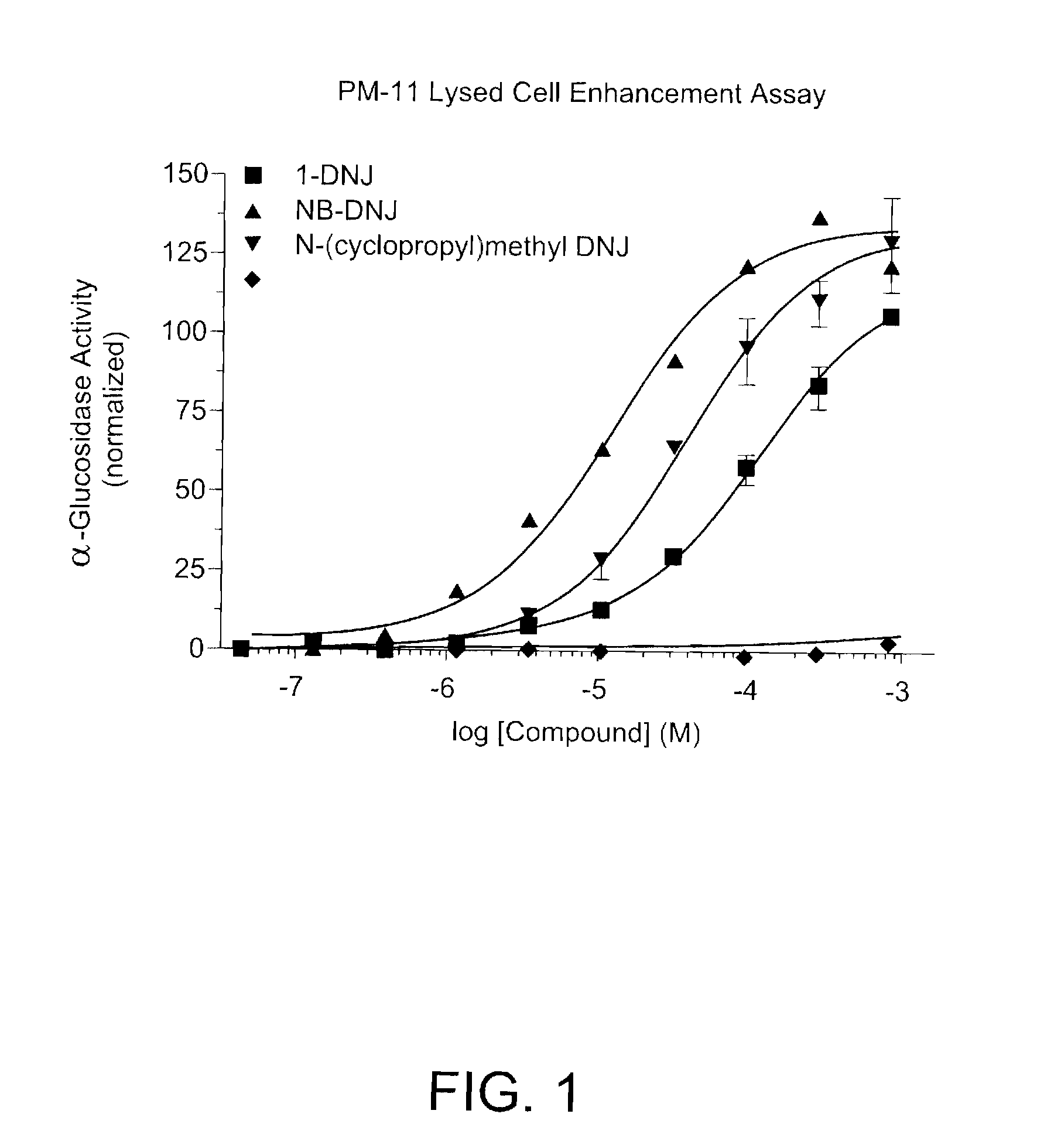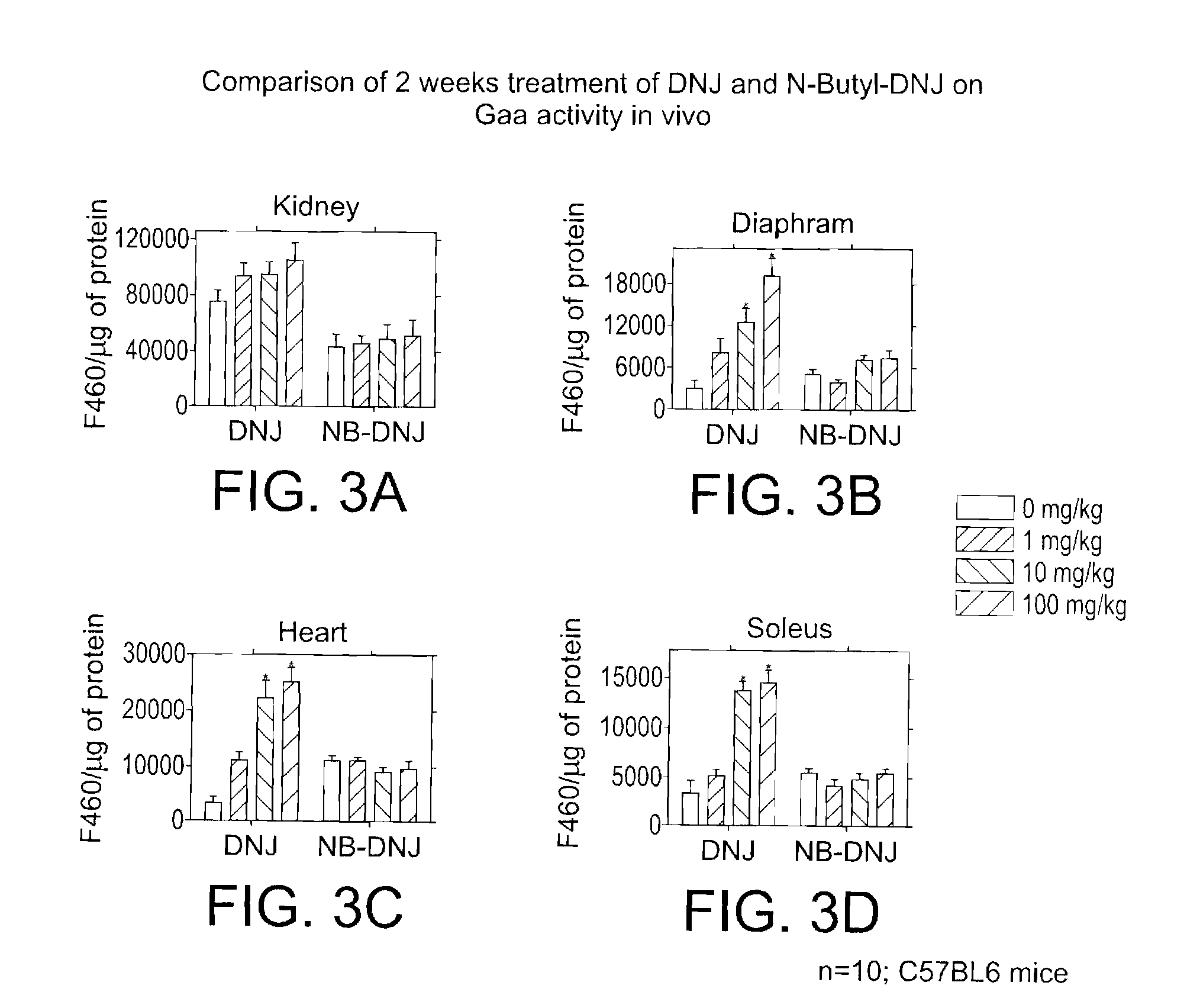TREATMENT OF POMPE DISEASE WITH SPECIFIC PHARMACOLOGICAL CHAPERONES AND MONITORING TREATMENT USING SURROGATE MARkERS
a technology of specific pharmacological chaperones and surrogate markers, which is applied in the field of pompe disease treatment with specific pharmacological chaperones and monitoring treatment using surrogate markers, can solve the problems of difficult screening for spc enhancement of gaa and difficulty in predicting responsiveness of specific mutations
- Summary
- Abstract
- Description
- Claims
- Application Information
AI Technical Summary
Benefits of technology
Problems solved by technology
Method used
Image
Examples
example 1
Enhancement of Gaa with DNJ and DNJ Derivatives
[0087]Experiments described below indicate that DNJ and DNJ derivative N-butyl-DNJ, known inhibitors of enzymes responsible for glycolipid synthesis, also can bind to and enhance the activity of mutant Gaa without inhibiting glycolipid synthesis.
Methods
[0088]Cell culture and seeding. The PM11 (P545L). PM8 and PM12 (both slicing defect), fibroblast cell lines was used for enhancement experiments. These cells are fibroblasts isolated from a Pompe patient. Cells were seeded at about 5000 cells per well in 180 μL media in sterile black clear-bottom 96 well Costar plates and incubated for about 3-6 hours at 37° C. with 5% CO2. Media consisted of DMEM with 10% FBS and 1% penicillin / streptomycin.
[0089]Drug Treatment. All test compounds are dissolved in 1:1 DMSO:H2O to a stock concentration of 100 mM. Serial dilutions of the cells using another sterile black clear-bottom Costar plate were performed as follows:
[0090]1. 20 μL of 1:1 DMSO:H20 and ...
example 2
In Vivo Gaa Activity Upon Treatment with DNJ and DNJ Derivatives
[0103]Drug administration. This Example provides information on the effects of DNJ derivatives on mice. The DNJ derivative test compounds were administered to the mice at 0, 1 mg / kg / day; 10 mg / kg / day; and 100 mg / kg / day; organs and plasma were collected at 2 and 4 weeks after initiation of the study. Twenty male C57BL6 (25 g) mice per group were used. The drug was given in the drinking water, therefore water consumption was monitored daily.
[0104]In the control group (0 mg / kg / day), the mice were dosed daily in the drinking water (no drug) and divided into two groups. Ten animals were euthanized after 2 weeks of treatment, blood was collected from the descending aorta or vena cava, and tissues were harvested and then necroposied. After 4 weeks of treatment, the remaining 10 animals were euthanized, and subjected to the same evaluation.
[0105]In the first test group, 20 mice were dosed daily in the drinking water with an adm...
example 3
Accumulation and Localization of Gaa with and without Exposure to DNJ Derivatives
[0114]In this experiment, four cell lines derived from Pompe patients who exhibited little to no residual Gaa activity were compared with wild-type fibroblasts for accumulation and localization of Gaa.
Methods
[0115]Cell lines. PM8, PM9, PM11, and PM12 cell lines were evaluated. PM8 harbors a splicing defect resulting in some residual Gaa activity (IVS1AS, T>G, −13); PM9 harbors a nonsense mutation on one allele (R854X) and 3 missense mutations on the other (D645E, V816I, and T927I) and has essentially no residual Gaa activity (A / M519V).
[0116]Immunofluorescence and microscopy. Cells cultured for 5 days with or without were grown for 5 days on glass coverslips with NB-DNJ. Cells were fixed with 3.7% paraformaldehyde for 15 minutes, permabilized with 0.5% saponin for 5 minutes, then labeled with a 1:300 dilution of rabbit anti-human Gaa (gift from Barry Byrne) and / or mouse monoclonal anti-LAMP1 (BD Pharming...
PUM
 Login to View More
Login to View More Abstract
Description
Claims
Application Information
 Login to View More
Login to View More - R&D
- Intellectual Property
- Life Sciences
- Materials
- Tech Scout
- Unparalleled Data Quality
- Higher Quality Content
- 60% Fewer Hallucinations
Browse by: Latest US Patents, China's latest patents, Technical Efficacy Thesaurus, Application Domain, Technology Topic, Popular Technical Reports.
© 2025 PatSnap. All rights reserved.Legal|Privacy policy|Modern Slavery Act Transparency Statement|Sitemap|About US| Contact US: help@patsnap.com



